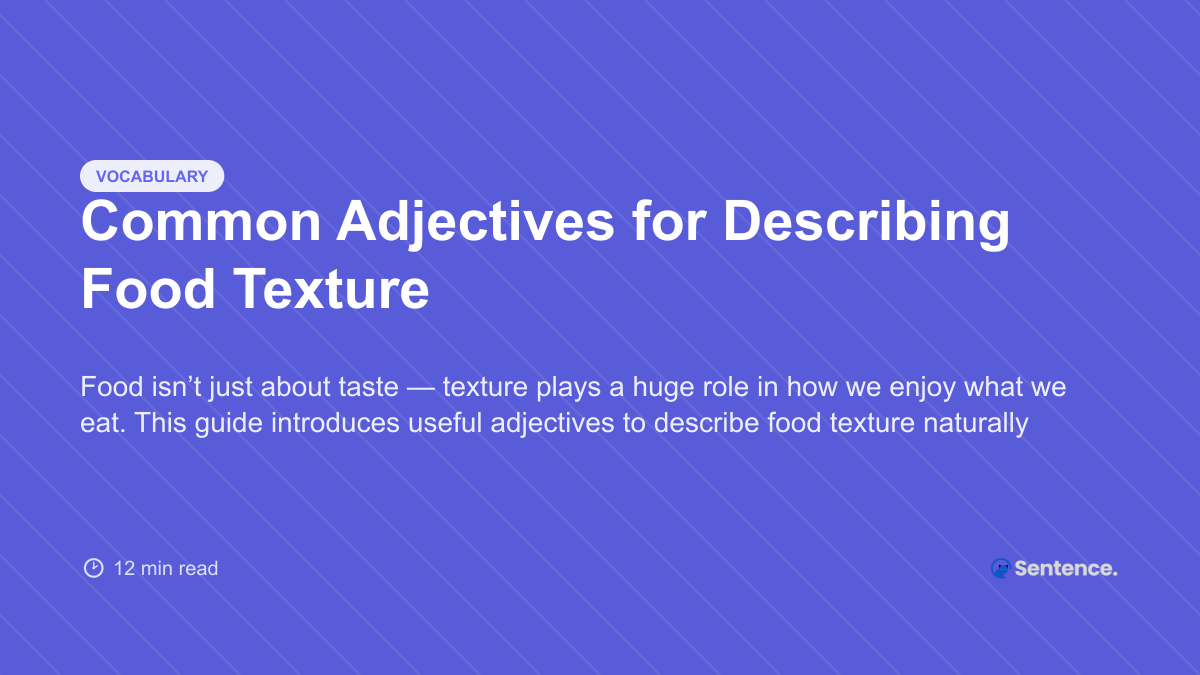
Common Adjectives for Describing Food Texture
Food isn’t just about taste — texture plays a huge role in how we enjoy what we eat. This guide introduces useful adjectives to describe food texture naturally and accurately.

Food isn’t just about taste — texture plays a huge role in how we enjoy what we eat. This guide introduces useful adjectives to describe food texture naturally and accurately.
When talking about food, many learners focus only on taste: sweet, salty, spicy, or bitter. But texture is just as important in English, especially when describing dishes, giving opinions, or reading recipes. Learning the right adjectives helps you express how food feels when you bite, chew, or touch it.
This article introduces practical English adjectives for describing food texture, grouped by category. Each word includes a clear meaning with examples to help you use them confidently in daily conversations, reviews, or cooking discussions.
Some foods make a sound when you bite into them or feel firm on the outside. These adjectives help you describe foods that are enjoyable because of their bite or crispness. They are common in snack descriptions, cooking shows, and restaurant menus.
| Adjective | Meaning | Example |
|---|---|---|
| crispy | firm and dry on the outside | The chicken was perfectly crispy. |
| crunchy | hard enough to make a noise when bitten | I love crunchy granola for breakfast. |
| firm | solid but not hard | The apples were fresh and firm. |
| brittle | easily broken into pieces | The candy was so brittle it snapped instantly. |
These words are excellent for describing fried foods, snacks, vegetables, or anything with a strong bite or satisfying crunch.
Many foods feel soft, silky, or gentle in the mouth. These adjectives describe texture that is pleasant, easy to chew, and often associated with comfort foods or desserts. They are common in cooking instructions and food reviews.
| Adjective | Meaning | Example |
|---|---|---|
| soft | easy to press or bite | The bread is fresh and soft. |
| smooth | without lumps or roughness | The soup has a smooth texture. |
| creamy | rich and thick like cream | This pasta sauce is extremely creamy. |
| tender | easy to cut or chew, especially meat | The steak was so tender it melted in my mouth. |
These adjectives help describe comfort foods, dairy-based dishes, mashed foods, and desserts that feel soft and pleasant on the tongue.
Some foods require more chewing or stick to your teeth. These adjectives are useful for describing unique or playful textures, often found in candies, baked goods, noodles, or traditional dishes from different cultures.
| Adjective | Meaning | Example |
|---|---|---|
| chewy | requires effort to chew | The cookies were a bit too chewy. |
| sticky | sticks to surfaces or teeth | This rice cake is soft and sticky. |
| stretchy | able to pull and stretch | The cheese on the pizza was wonderfully stretchy. |
| rubbery | too tough or elastic in a bad way | The squid turned out rubbery after overcooking. |
These textures are common in Asian desserts, Italian cuisine, and certain meats or candies that are meant to feel elastic or sticky.
Some foods contain a lot of liquid or release moisture when eaten. These adjectives are especially useful when describing fruits, salads, meat, or dishes with broth and sauce. Knowing the right words helps you express whether the moisture adds freshness or makes the dish less appealing.
| Adjective | Meaning | Example |
|---|---|---|
| juicy | full of liquid or moisture | The mango was incredibly juicy. |
| moist | slightly wet in a pleasant way | The cake was soft and moist. |
| watery | too thin or lacking thickness | The soup tasted bland and watery. |
| runny | thinner than expected | The sauce was too runny for my liking. |
These adjectives help you express whether the liquid content improves the dish or makes it feel weak, thin, or overly moist.
Food texture is easier to remember when you connect the words to real foods you’ve eaten. Try imagining the crispy skin of fried chicken, the creamy texture of mashed potatoes, or the chewy pull of fresh noodles. These mental images give each adjective a clear meaning and help you recall the right word naturally when speaking or writing about food.
Memory Tip:
Think about how the food feels in your mouth — not how it tastes — to choose the right texture adjective.
Answers: moist / brittle / chewy / juicy
⭐ Pro Tip: Food bloggers, chefs, and reviewers rely heavily on texture words — using them makes your descriptions more vivid and professional.
Texture vocabulary brings food descriptions to life, making your speaking and writing more vivid, accurate, and expressive. Whether the food is crispy, chewy, creamy, or juicy, using the right adjective helps listeners and readers imagine exactly what you mean. With a bit of daily practice, these texture words will become a natural part of your English vocabulary.